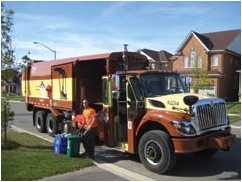
Digging into Ottawa’s Garbage
From our kitchens and gardens to processing plants and commercial buildings, people and companies all generate one thing with increasing logistical and environmental concern: garbage. In green or blue bins, plastic bags or industrial containers, what we put at the curb is either recycled, processed into forms of energy or dumped into landfills. Understanding what happens to the waste we generate is in our best interest as taxpayers and protectors of our environment.
The Citizen Garbage Producer
Everything we consume produces waste—food packaging, the clothes we wear and the cars we drive. Living the way we do simply generates a lot of garbage. According to the City of Ottawa’s statistics, residents produce approximately 200,000 tonnes of household waste annually. This waste is all disposed of at the Trail Waste Facility, with the exception of the previous Township of Osgoode, where waste is transported to the Springhill Landfill near Metcalfe. Both of these landfill sites are owned by the City, but only the Trail Waste Facility is city-operated, while the Springhill Landfill is run privately.
So who’s in charge of collecting all this waste and delivering it to these facilities? Residential waste collection is tendered out competitively through contracts.
“The City also bids on the tender,” added Marilyn Journeaux, Manager of Solid Waste Services at the City. “Currently there is a mixture of private and public sector waste collection.”
Financing this process of waste collection and management is made possible through the City’s Solid Waste Management operating budget of $67.6 million. As part of the City’s long term Waste Strategy and to extend the life of the landfill facilities, the City also operates the blue and black bin recycling programs, which are expected to divert about 30,000 to 50,000 tonnes of waste annually.
Recognizing that about 45 per cent of Ottawa’s garbage is organic material, the City implemented the green bin program in January 2010 to collect organic waste and convert it to compost. Once delivered to the composting facility, the waste is mixed with seed and spread across tunnels that heat up the material to enhance the natural decay process while killing harmful bacteria. Then it is put through a screener to remove containments and heavy solids. The City keeps 10 per cent of the resulting compost for community-based tree planting and gardening while the facility keeps 90 per cent, sharing compost with Ottawa farmers. The green bin program is expected to divert 70,000 to 80,000 tonnes of waste from Ottawa’s landfills.
Recently, the City also implemented bi-weekly household garbage pickup to encourage residents to recycle and decrease the amount of garbage at the curb.
“We’re also entering into a contract to gasify the residual residential waste,” said Journeaux. “The success of these programs will significantly extend the life of the City’s landfills. Waste Management is in the process of seeking approval to expand the privately owned Carp Landfill in the west end of Ottawa. Taggart Miller is also in the process of seeking approval for a new landfill site in the east end of Ottawa.”

Managing Commercial and Industrial Waste
Waste produced by construction development and large-scale industry presents a different challenge—material can be difficult to efficiently transport and is often composed of a variety of substances from natural fibres like wood to metals, concrete and synthetics. The provincial government controls this waste generated by industries, commercial enterprises and institutions.
In a joint venture with Taggart Construction Limited, Miller Waste Systems Inc. proposed a commercial waste management project for Ottawa, currently undergoing review. Intended to serve the commercial, industrial and institutional sector, the project has ambitious plans to change the way this waste is managed and increase the diversion rate.
“If you look at statistics across the provinces, we divert about 12 per cent of commercial and industrial waste from landfills—that’s a lot less than the residential sector,” explained Nigel Guilford, General Manager at Miller Waste Systems Inc. “Part of the problem is a lack of facilities to manage this waste and we’re proposing to provide these facilities if the project is approved.”
Since 1961, the core of the company’s business has included recycling and waste processing services to many municipalities in the Greater Toronto Area and Nova Scotia. Taking the expertise acquired from managing residential waste, Miller wants to apply this knowledge to its proposal for dealing with commercial and industrial waste using innovative methods.
“The contents of the waste dictate our choices, options, equipment and resources,” said Mr. Guilford. “We are proposing to concentrate all waste diversion activities for industrial and commercial sources at a single location, which means we’ll build a landfill site for the residue and material copy process. By having all these elements on one site, we have more operating and financial flexibility in the way we provide services. We’ll be able to balance the waste stream and recover more from it.”
The building of this new landfill in the City’s east end is not welcomed by all. Residents strongly oppose it, citing a number of concerns for the environment and nearby community, including toxic odour.
“We’re aware of the public’s concerns and understand they are worried about their property values diminishing,” said Mr. Guilford, also a board member of the Ontario Waste Management Association. “I haven’t seen that happen in my experience in this industry. There are challenges we hope to meet but landfills are now strictly regulated and controlled by the Waste Diversion Act. It wasn’t always like this but Ontario has great stringency in landfill standards. We can help divert a significant amount of waste from landfills to reduce environmental impact.”
As part of the plan to recover value from commercial and industrial waste, he said it would implement a number of methods to divert the volume of waste entering the landfill as much as possible. Construction and demolition waste, for example, are composed mostly of masonry and wood. Masonry can be crushed and used for roadbed or other construction purposes while wood can be ground up and turned into horticulture material like mulch or biofuel. For the organic waste generated by large-scale companies, Mr. Guilford said Miller is proposing to build an anaerobic digester, which is a process that takes place in the absence of air. Microbes devour the waste, producing a biogas with equal portions of methane and carbon dioxide which be used for creating energy like electricity or industrial fuel. By keeping this organic waste from entering the landfill, harmful gas produced by decaying material can be prevented from entering the atmosphere, as well as liquid that collects at the bottom of the landfill, requiring treatment.
While there is still an extensive process involving an environmental assessment, government reviews and rezoning, Mr. Guilford said he is hopeful the project will receive full approval next year, allowing construction to begin in two years.
“We are making a huge investment—$100 million over its duration,” he said. “We’re doing this in the belief and expectation that we can change the way commercial and industrial waste is managed. This is an investment in our future, by finding a way to do things differently. It’s our belief corporately that we can’t continue to divert waste the way we are now because it makes shor-term economic sense, but not long-term environmental sense.”
Adding that the provincial government is currently reviewing the Waste Diversion Act and will seek industry input, Mr. Guilford said there still needs to be regulations for waste generators to keep materials separate. This will allow waste management companies to extract more energy and divert waste.
Extracting Energy from Waste
While many cities around the world, including Ottawa, are taking positive action towards reducing waste, the reality is that we still bury a large amount of it. Home-grown technological innovation backed by 30 years of research and development is now providing a solution to this complex problem—it is converting solid waste into a synthetic gas that can be used in engines to generate electricity. Plasco Energy Group Inc. was developed in Ottawa and represents an alternative to the City’s Trail Road landfill for handling post-recycled waste. In 2006, Plasco partnered with the City of Ottawa and Sustainable Development Technology Canada to build the world’s first and only commercialscale facility to demonstrate this innovation: Plasco Trail Road. The facility recycles metals, provides water for reuse in communities and recovers energy from waste otherwise destined for landfills.
“Plasco’s approach is to fit and complement the ‘3 Rs’ of waste management, as well as create value by adding a fourth ‘R’ in recovery,” said Amanda Gorchinski, Manager of Marketing and Communications at Plasco. “As a new technology in an emerging industry, we also recognize the need to address and mitigate risk for the community. That’s why it is our responsibility to finance the construction and ongoing operations of our facility.”

facility and mixed with seed. It is then spread
across tunnels that heat up the material to
enhance the natural decay process.
(Photo Courtesy Plasco Energy Group)
The conversion process is unique because it is highly efficient and uses plasma torches to refine the synthetic gas; the plasma torches are used more for their catalytic properties than for heat, thus reducing energy consumption. The engines that use the resulting synthetic gas to generate electricity are also more efficient than steam turbines, added Gorchinski. Plasco’s future plans could see this gas used to produce fuels or chemicals.
Dedicated to minimizing its environmental footprint, Plasco has invested in gas cleaning technologies to guarantee that the synthetic gas it produces is as clean as possible. Its pollution control systems allow the facility to “meet or beat” environmental standards. Due to this stellar environmental performance, which was confirmed by the Ontario Ministry of Environment, the facility was granted permanent operation permits in 2011.
“Plasco also reduces the negative environmental impacts of landfills by eliminating the creation of leachate and minimizing the effect of greenhouse gas production created by landfilling,” added Gorchinski. “We can actually improve local air quality compared to landfilling. Another environmental benefit of the technology is the non-leachability and non-toxicity of the slag that is produced and used commercially.”
The need for innovative waste diversion technologies has never been greater than today. As the City and the rest of Canada invest in new ways to reduce waste, Canadians can become more involved in the solution as opposed to merely generating the problem.








